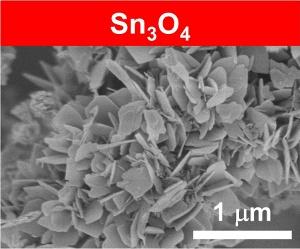An abundant and inexpensive water-splitting photocatalyst with low toxicity

Figure 1 from the press release material. Electron microscope imagery of Sn3O4 catalyst. The synthesized material is a collection of microsized (one millionth of a meter) flaky crystals. Copyright : National Institute for Materials Science (NIMS)
Technology that allows the direct conversion of sunlight, an ultimate renewable energy, into chemical energies (i.e., fuels) that can be condensed and transported is not yet available. As such, solar energy is not ready at present to be utilized in place of conventional fossil and nuclear fuels.
Many water-splitting photocatalysts, such as titanium dioxide (TiO2), can decompose water and produce hydrogen fuel when absorbing ultraviolet light. However, due to their inability to absorb visible light, which accounts for more than half of solar energy, their practical use in the conversion of solar energy is limited.
While the development of new photocatalysts that can split water by absorbing visible light has been worked on globally, there are cost- and environment-related issues because many of the available photocatalysts contain expensive rare metals, such as tantalum, or high concentrations of lead, which is very toxic.
Led by Hideki Abe and Naoto Umezawa, researchers at Japan's National Institute for Materials Science (NIMS) recently discovered a novel photocatalyst by integrating both theoretical and experimental sciences.
The NIMS team searched for oxides containing divalent tin ions (Sn2+) based on the theoretical prediction that such substances may have an electronic structure conducive to water-splitting photocatalytic reactions under the presence of visible light.
As a result, they found a tin oxide, Sn3O4 (Sn2+2Sn4+O4), that is made up of divalent tin ions (Sn2+) and tetravalent tin ions (Sn4+). Their experiment revealed that this substance facilitates a water-splitting reaction leading to the generation of hydrogen when exposed to visible light which does not activate TiO2.
Since tin oxides are relatively non-toxic, inexpensive and abundant, they are widely used as transparent conductive materials. The discovery of the Sn3O4 catalyst is expected to greatly contribute to the reduction of environmental load and costs associated with hydrogen fuel production, and to the realization of a recycling-oriented society founded on the use of solar energy.
Results of this research will be published in the near future in the online version of Applied Materials & Interfaces, a journal issued by the American Chemical Society.
Associated links
Media Contact
More Information:
http://www.researchsea.comAll latest news from the category: Materials Sciences
Materials management deals with the research, development, manufacturing and processing of raw and industrial materials. Key aspects here are biological and medical issues, which play an increasingly important role in this field.
innovations-report offers in-depth articles related to the development and application of materials and the structure and properties of new materials.
Newest articles

High-energy-density aqueous battery based on halogen multi-electron transfer
Traditional non-aqueous lithium-ion batteries have a high energy density, but their safety is compromised due to the flammable organic electrolytes they utilize. Aqueous batteries use water as the solvent for…

First-ever combined heart pump and pig kidney transplant
…gives new hope to patient with terminal illness. Surgeons at NYU Langone Health performed the first-ever combined mechanical heart pump and gene-edited pig kidney transplant surgery in a 54-year-old woman…

Biophysics: Testing how well biomarkers work
LMU researchers have developed a method to determine how reliably target proteins can be labeled using super-resolution fluorescence microscopy. Modern microscopy techniques make it possible to examine the inner workings…





















